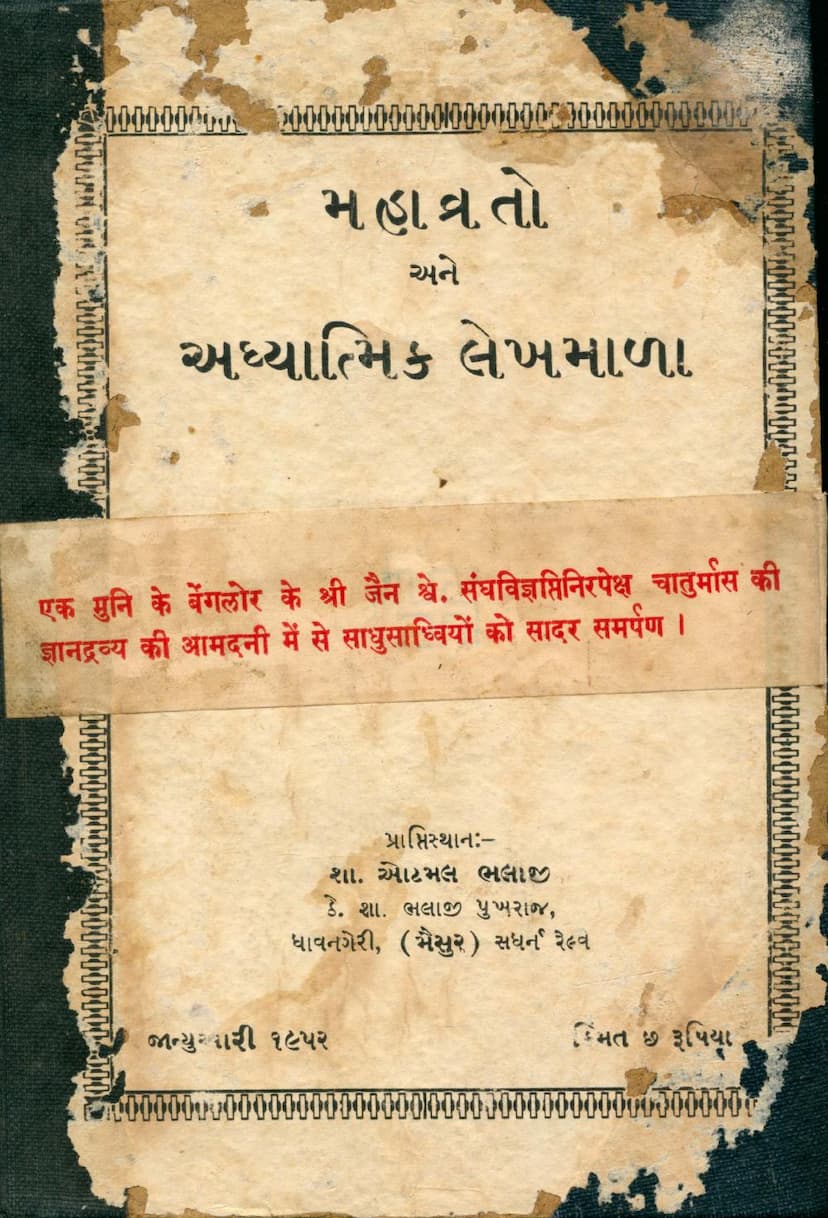Mahavrato Ane Adhyatmik Lekhmala
Added to library: September 2, 2025

Summary
Based on the provided Jain text, "Mahavrato Ane Adhyatmik Lekhmala" by Sha Ratanchand Shankarlal, here's a comprehensive summary in English:
Book Title: Mahavrato Ane Adhyatmik Lekhmala (Great Vows and Spiritual Essay Series) Author: Sha Ratanchand Shankarlal Publisher: Sha Ratanchand Shankarlal
Overall Summary:
This collection, "Mahavrato Ane Adhyatmik Lekhmala," primarily consists of spiritual discourses and essays, likely compiled from lectures or writings by esteemed Jain scholars and Acharyas. The core of the text revolves around understanding and practicing Jain principles, particularly the Mahavratas (Great Vows), and delving into the deeper spiritual aspects of Jainism. The book serves as a guide for spiritual upliftment and adherence to Jain conduct.
Key Themes and Content:
-
The Importance of Jain Agamas: The text emphasizes the foundational role of Jain Agamas, particularly highlighting the significance of the Acharaanga Sutra (detailing the conduct of monks), Sutra Gadaanga (discussing philosophical principles), and Sthaanaanga Sutra (classifying substances and principles). It underscores that these Agamas are "artha-pradhaan" (meaning-centric), unlike non-Jain scriptures which are considered "shabd-pradhaan" (word-centric).
-
The Five Great Vows (Pancha Mahavratas): A central theme is the detailed explanation and importance of the five great vows, which are the bedrock of Jain spiritual practice. These are discussed in terms of their philosophical underpinnings, their practical application, and their profound impact on the soul's journey towards liberation. The text likely elaborates on:
- Ahimsa (Non-violence): Understanding the forms of violence, the significance of avoiding it in thought, word, and deed, and its paramount importance.
- Satya (Truthfulness): The nuances of truthfulness and its role in spiritual progress.
- Asteya (Non-stealing): The principle of not taking what is not given.
- Brahmacharya (Celibacy/Chastity): The importance of controlling sensual desires.
- Aparigraha (Non-possession): The concept of detachment from possessions and its spiritual benefits.
-
Spiritual Insights and Philosophical Discussions: The book delves into various spiritual concepts crucial for Jain followers. These include:
- The Nature of Karma: Explanation of karmic bondage (ghati and aghaati karma), their effects, and the path to their destruction for liberation.
- The Soul (Jiva) and Non-Soul (Ajiva): Understanding the distinction and interaction between these fundamental Jain principles.
- The Path to Liberation (Moksha): The ultimate goal of Jainism, achieved through right faith (Samyak Darshan), right knowledge (Samyak Gyan), and right conduct (Samyak Charitra).
- The Significance of Vows and Practices: The text likely explains the proper adherence to vows, the meaning behind various rituals, and the importance of spiritual practices like meditation and austerities.
- The Role of External Conduct (Bahya Achar) and Internal Purity (Antar Shuddhi): While external conduct is important, the emphasis is on its connection to and reflection of internal purity.
- The Role of Acharyas and Gurus: The importance of following the guidance of enlightened spiritual leaders.
- Critique of Misconceptions: The text addresses and clarifies common misunderstandings about Jainism, possibly contrasting it with other philosophies and refuting incorrect interpretations.
-
Specific Topics Covered (as indicated by the table of contents and text excerpts):
- The greatness of adherence to the Mahavratas in Kaliyuga.
- The role of various principles like Ghati and Aghati karma, Bhavatva, and the meaning of "Michhami Dukkkadam."
- Discussions on the authenticity and interpretation of Agamas.
- The importance of virtuous conduct (Achar) as the foundation of Jainism.
- The philosophy behind idol worship and the significance of spiritual practices.
- The nature of desires, attachments, and the path to overcoming them.
- The distinction between material and spiritual wealth.
- The concept of soul-consciousness (Chetaana) and its relation to the soul.
- The importance of seeking the right spiritual guide (Guru).
- The philosophical differences between Jainism and other religions, particularly regarding concepts like karma, soul, and liberation.
- The role of various scriptures like Acharaanga, Sutra Gadaanga, and Sthaanaanga.
- The author also provides insights into the lives and teachings of prominent Jain Acharyas like Acharya Shri Anand Sagarsurishwarji Maharaj Saheb and Acharya Shri Vijayramchandrasurishwarji.
Structure and Style:
The book is presented as a collection of spiritual essays or discourses, offering detailed explanations of Jain philosophy and practice. The language is likely scholarly and devotional, aiming to enlighten and inspire the reader towards a deeper spiritual understanding and commitment. The table of contents reveals a wide array of topics, indicating a comprehensive approach to Jain spiritual teachings. The publisher's note and the catalog link suggest that this is a valuable resource for those seeking to understand Jainism in depth.
Target Audience:
The text is intended for Jain followers and anyone interested in understanding the spiritual and philosophical dimensions of Jainism. It caters to those seeking guidance on living a virtuous life, understanding karmic principles, and progressing on the path to spiritual liberation.
In essence, "Mahavrato Ane Adhyatmik Lekhmala" is a profound exploration of Jain spiritual philosophy, emphasizing the practical application of its core tenets, particularly the Great Vows, for the ultimate goal of soul purification and liberation.